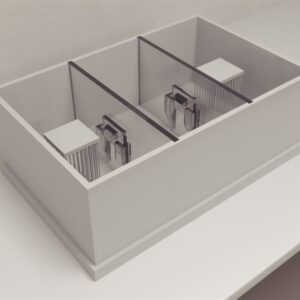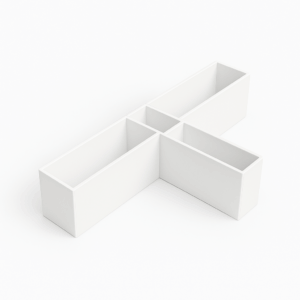$7,890.00 – $8,190.00Price range: $7,890.00 through $8,190.00
The self-administration chamber is designed for evaluating reward-seeking behaviors and addiction. This chamber provides all the necessary components for operant conditioning assessments related to food restriction and intravenous substance delivery. The data that can be gathered includes:
Maze Engineers offers self-administration chambers tailored for both mice and rats, with dimensions of 18 cm (l) x 18 cm (w) x 20 cm (h) for mice and 26 cm (l) x 26 cm (w) x 25 cm (h) for rats.
Our chamber features a soundproof cubicle equipped with lighting and a fan, a syringe pump system, a cage with dual portlights and retractable levers, a shock floor grid, and two receptacles for pellets. Additionally, an optional optic sensor for detecting nose pokes can be included.

MazeEngineers empowers preclinical neuroscience research with meticulously designed, customizable behavioral apparatuses. From manual classic mazes to fully automated smart systems, we provide the tools scientists need to capture high-quality, reproducible data for studies on learning, memory, anxiety, and depression.



Mouse |
Single chamber size: 18cm (l) x 18cm (w) x 20cm (h) |
(2) Levers or Nose Pokes |
(2) LED visual stimuli |
(1) Shock Grid |
(2) Pellet Receptacles |
(2) Pellet Dispenser |
(1) Syringe pump system |
Feces and urine tray |
Isolation cubicle with (1) speaker; (1) house light; (1) circulation fan; (1) IR light after fan |
Conduct Software: $1490 |
Conduct Software: $1490 |
Rat |
Single chamber size: 26cm (l) x 26cm (w) x 25cm (h) |
(2) Levers or Nose Pokes |
(2) LED visual stimuli |
(1) Shock Grid |
(2) Pellet Receptacles |
(2) Pellet Dispenser |
(1) Syringe pump system |
Feces and urine tray |
Isolation cubicle with (1) speaker; (1) house light; (1) circulation fan; (1) IR light after fan |
Conduct Software: $1490 |
Conduct Software: $1490 |
Yes, there is a User Manual for the Self-Administration Chamber.
The software comes with the hardware system. The system is a complete system so you can run it when you receive it. The hardware components are detailed in the hardware manual.

Take advantage of Neuralynx, Ethovision Integration, SMS and Email integration with the Conductor Science Software. No I/O Boxes Required

The Self-Administration Chamber is a widely used operant behavioral assay for studying reward-seeking and addiction behaviors (refer to the Self-Administration Runway for more information). Research on substance abuse and addiction in humans often relies on empirical findings (for digital health resources, check ConductScience Digital Health), but these studies may not fully capture the complexities of the mechanisms and factors driving these behaviors. Animal studies utilizing self-administration can help navigate ethical challenges and reduce the variability introduced by individual differences in human research.
The shift from voluntary substance use to addiction involves a developmental-learning process at the neural level, akin to behaviors driven by strong reward-seeking motivation (Everitt & Robbins, 2005; Lewis, 2017). The Self-Administration Chamber facilitates the exploration of instrumental reinforcers that encourage substance-taking and seeking behaviors. This chamber features a straightforward setup of levers and light cues, along with an optional reward dispenser, all housed in a soundproof cubicle. Subjects learn to connect lever pressing with substance administration, enabling the evaluation of the reinforcing effects of various compounds. While the neural mechanisms underlying substance addiction are crucial, external factors such as social influence (Piña et al., 2018) and the presence of co-occurring mental health disorders (Volkow, 2001) also play significant roles in substance abuse. Social influences can be examined using multiple Self-Administration Chambers, while mental health factors can be incorporated through various mental illness models. The chamber also includes electrified grid flooring, allowing for the integration of fear-learning protocols with self-administration tasks (see the Fear-Conditioning Chamber for more details).
Protocol automation is possible with the Conductor Software. Additional rodent operant assays include the IDED Operant Chamber, the Attentional Set Shifting (IDED) Chamber, and the Operant Conditioning Chamber (see Operant Chamber Packages for further options).
The Self-Administration Chamber is an acrylic structure measuring 26 × 26 × 30 cm, with a smaller model for mice at 18 × 17 × 25 cm. It features clear acrylic side walls and aluminum for the remaining two walls. Each chamber includes pairs of portlights available in yellow, red, or green, along with retractable levers. Positioned between the levers is the pellet or liquid receptacle, which can be a pellet dispenser or lickometer. An optional optic sensor for detecting nose pokes is also available.
For maintenance ease, the chamber is designed with a removable electric grid floor and a detachable tray for collecting feces and urine. The grid floor consists of rods with a diameter of 6 mm and a spacing of 5 mm (the mouse model features 4 mm rods with 5 mm spacing). The shock intensity can be adjusted from 0.1 to 4 mA in increments of 0.1 mA, with the shock generator located externally.
Additionally, the chamber is housed within a sound-attenuating enclosure (50 × 40 × 40 cm), which is equipped with a speaker, a house light, a circulation fan, and a syringe pump system. This syringe pump system includes a variable-speed pump, a vascular access harness, and a tether kit for the animal.
Clean the apparatus and the testing chamber prior to beginning the sessions and in between trials to prevent the influence of any lingering stimuli on the performances. Multiple animals can be tested at a time. However, testing conditions should be maintained for the groups throughout the sessions. The Self-Administration Chamber task requires food or liquid restrictions before sessions to motivate the subjects to complete the task.
Self-Administration Chamber task protocols vary depending on the requirements of the investigation. The following are the common approaches to the task (Thomsen, & Caine, 2005)
Following is a sample protocol for self-administration tasks using a lever manipulandum.
After the post-surgery rest period, initiate acquisition trials for self-administration using a fixed ratio 1 schedule. Start each session with a priming injection of the substances. Each lever press will result in compound administration, accompanied by the activation of a flashing stimulus light. Following each press, implement a time-out period (lights off) lasting 30 seconds during which no activity or reinforcement occurs. Each session should last 180 minutes, with a maximum limit on the number of injections. Acquisition trials will conclude when the subject meets the predefined criteria for minimum self-administration and maintains an active-to-inactive lever press ratio over three consecutive sessions.
Next, transition to training sessions under a fixed ratio 2 schedule, providing unlimited reinforcers. Each session will last 90 minutes, continuing until a stable baseline for substance intake is established over three consecutive sessions.
Perform test trials that replicate the training sessions, except the priming dose will match the dose under investigation. Evaluate each dose separately on successive days. Conclude this phase with trials using saline only.
Introduce the subject to both active and inactive levers, but configure them so that pressing either lever results in no consequences. Monitor extinction behaviors for a duration of 30 to 90 minutes.
For optimal results, relapse-reinstatement sessions should take place following a period of enforced abstinence. The protocol outlined here includes three conditions for reinstatement induction: conditioned stimuli, stress, and substance infusion.
Begin with extinction trials, then proceed to a reinstatement test triggered by conditioned stimuli without any substance infusion. In the first 30 minutes, present the conditioned stimuli (a cue light linked to substance infusion) non-contingently for 20 seconds. This is followed by another 30-minute segment in which the conditioned stimuli are presented contingent upon active lever presses, lasting 2 seconds, on a fixed ratio 1 schedule. Conclude this phase with a foot shock, immediately followed by 30 minutes of observing nonreinforced responses. The next reinstatement phase will commence with a 30-minute period of noncontingent substance infusion.
The following observations can be made in the Self-Administration Chamber Task,
The Self-Administration Chamber is compatible with both nose-poke and lever manipulanda. While the nose-poke system is often seen as more instinctive for rodents, the lever system is just as effective. This lever system features retractable levers, which can be beneficial during the acquisition phase or when the subject is inactive. Additionally, the chamber accommodates both liquid and food rewards.
Equipped with a speaker, light, and electric grid flooring, the chamber enables various combinations of conditioning cues. The electric grid flooring is particularly valuable for assessing stress and fear-induced reward-seeking or substance abuse behaviors. Unlike the Self-Administration Runway, this chamber assay does not incorporate a locomotor element.
Inadequate post-surgery care can significantly impact self-administration performance. For protocols that involve pretraining with appetitive rewards, it’s essential to implement liquid or food restrictions to sustain the subject’s motivation during trials. Poor handling of the subject can lead to stress, further influencing performance outcomes. Additionally, variables such as age, strain, species, and sex can also play a role in performance variability. Moreover, any alterations in the environment or food rewards may affect the results.
| Species | Mouse, Rat |
|---|
There are no questions yet. Be the first to ask a question about this product.